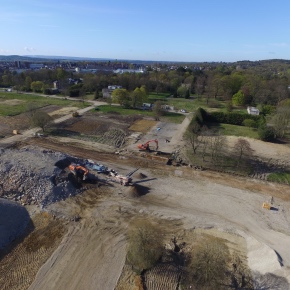
The increasingly important role of drones in construction
Drones, or unmanned aerial vehicles (UAVs), are one of the hottest gadgets on the market right now but, increasingly, their commercial potential is being recognised. Of course, there are obvious applications such as delivery, which Amazon and Domino’s are currently testing, but drones have a huge role to play in the construction industry, too.
There are many reasons why construction firms are using drones more and more – let’s examine the benefits of UAVs, why they’re important and how to ensure they are being used appropriately.
Why use drones in construction?
There are many uses for drones within construction, as they are an excellent way to take bird’s-eye-view high quality images and video. This footage can be implemented into progress reports to show clients how the project is going and highlight possible restrictions or difficulties which might be encountered. Without drones, these types of images can only be captured via helicopter or light aircraft, and these options are considerably more expensive and time-consuming.
Moreover, drones are adept at reaching areas which humans cannot – either because they are too dangerous or awkward to access. Capturing images of these areas of the site is important and a drone can complete the task safely and quickly.
Some drones are capable of 3D mapping a specified area, allowing you to collect the data you need cost effectively. The project manager can overlay the images with the original blueprints, so they can spot any potential mistakes or issues straight away, before they become an expensive problem. Clients will appreciate being able to see a more in-depth view of their project, especially if it is being managed remotely.
Drones can be used for monitoring purposes, too. For example, if there’s a hazard that the site manager needs to keep an eye on, they can safely do so using a drone. This can help reduce the number of accidents and increase site safety.
How to use drones legally
If you want to use drones commercially, you can’t just purchase one and start using it straight away. First, you need to train your staff to fly the type of drone you’ve chosen competently. The Civil Aviation Authority (CAA), specifies that all unmanned aircrafts “must be flown in a safe manner, both with respect to other aircraft in the air and also to people and properties on the ground”, so the project manager using the drone must be aware of the rules and regulations involved.
You’ll need to be approved by the CAA to use the drone regularly in congested areas. This will include approval of the pilot(s), so it’s wise to provide them with training prior to applying for permission. Preferably, they will then be assessed by an approved National Qualified Entity. Training organisations such as Resource Group provide excellent training courses, which will teach your employees all the skills they need to effectively use drones on construction sites.
Your organisation and employees also need to be aware of no-fly zones and privacy laws, to ensure you operate your drones legally. For example, you must inform your employees (and anyone else on site) that you will be using a drone, as recording people without their knowledge is against the law. This means you should not use your drone to check up on your employees.
The drone must only be used for a specific purpose, which is the only time that recording should take place. If you’re capturing images within a crowded city centre, you need to ensure images of individuals outside your organisation are not captured. Furthermore, all video and images recorded should be stored securely.
There’s a lot of preparation, training and reading involved if you want to use drones at your construction sites, but this technology is worth it. You’ll save money, time and you’ll boost the relationship between your organisation and your clients. Plus, these impressive images are an excellent way to promote your firm – you may be able to use some in your marketing materials and on your social media channels to show off your latest projects.
If you want to keep up with your competition, drones are the way forward.
Author: Laura is an experienced brand journalist and content marketer working on behalf of Hughes & Salvidge.
Latest news

18th April 2024
Abloy UK showcases new digital portfolio at The Security Event 2024
Abloy UK is set to unveil its latest line-up of access control systems at The Security Event 2024, welcoming guests to explore its cutting-edge electromechanical and digital solutions on stand 5/F50.
Posted in Access Control & Door Entry Systems, Architectural Ironmongery, Articles, Building Industry Events, Building Industry News, Building Products & Structures, Building Services, Doors, Exhibitions and Conferences, Facility Management & Building Services, Health & Safety, Information Technology, Retrofit & Renovation, Security and Fire Protection
18th April 2024
Strand is a Failsafe Choice for Emergency Exit and Panic Hardware
In times of emergency, you’re in safe hands with Strand Hardware. Although there are many considerations for building specification, few decisions can be as critical as selecting the right emergency exit/panic hardware.
Posted in Access Control & Door Entry Systems, Architectural Ironmongery, Articles, Building Industry News, Building Products & Structures, Building Services, Doors, Facility Management & Building Services, Health & Safety, Restoration & Refurbishment, Retrofit & Renovation, Security and Fire Protection
18th April 2024
MRA appoints Callum Budd as Research Projects Director
MRA Research, the research agency focused solely on the construction sector, welcomes Callum Budd as its new Research Projects Director.
Posted in Articles, Building Industry News, Information Technology, news, Recruitment, Research & Materials Testing
16th April 2024
Mitsubishi Electric set to host CIBSE Journal webinar
Mitsubishi Electric will host a CIBSE Journal webinar on Wednesday 24th April 2024 at 1pm to discuss the legislation and initiatives driving changes in the way we will need to heat, cool and ventilate large commercial buildings to reach net zero emissions in the UK.
Posted in Air Conditioning, Articles, Building Industry Events, Building Industry News, Building Products & Structures, Building Regulations & Accreditations, Building Services, Facility Management & Building Services, Heating Systems, Controls and Management, Heating, Ventilation and Air Conditioning - HVAC, Information Technology, Pipes & Fittings, Plumbing, Seminars, Sustainability & Energy Efficiency, Training
 Sign up:
Sign up: